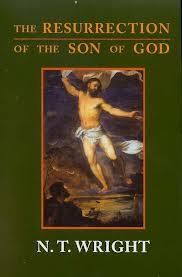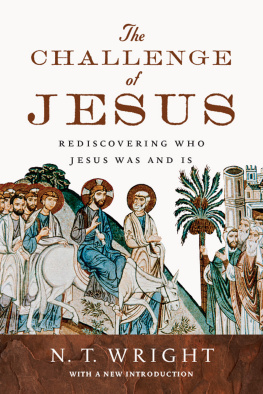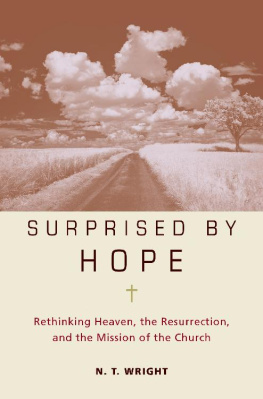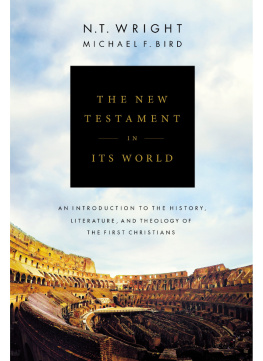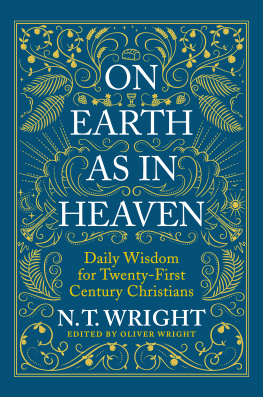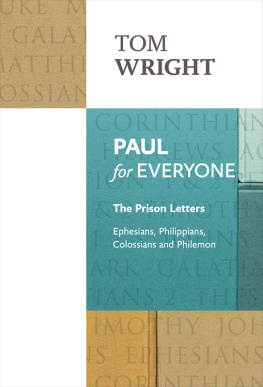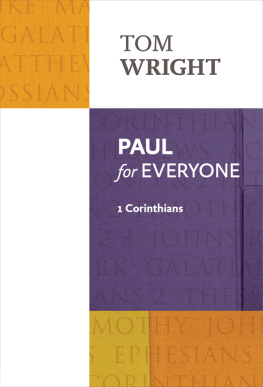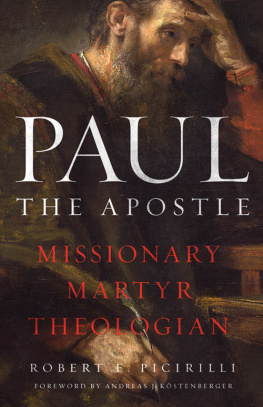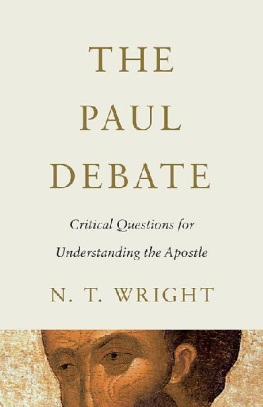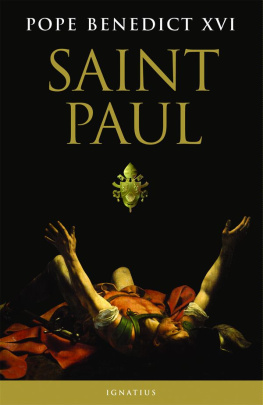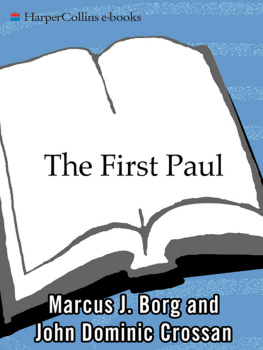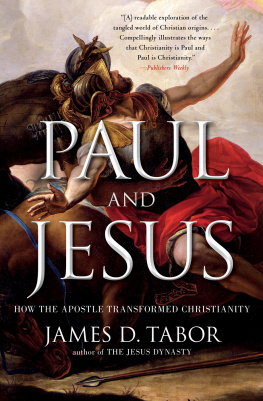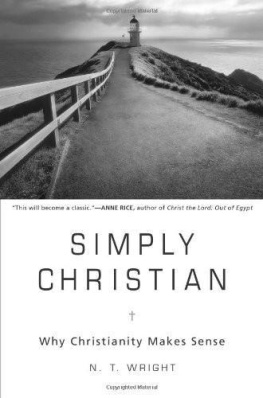T HE APOSTLE PAUL is one of a handful of people from the ancient world whose words still have the capacity to leap off the page and confront us. Whether we agree with him or notwhether we like him or not!his letters are personal and passionate, sometimes tearful and sometimes teasing, often dense but never dull. But who was he? What made him tick? And why did his seemingly erratic missionary career have such a profound influence on the world of ancient Greece and Rome and thereby on the world of our own day?
Any worthwhile answer must presuppose the detailed historical and theological study of his letters in debate with ongoing scholarship. I have tried to do this in The Climax of the Covenant (1991/1992), Paul and the Faithfulness of God (2013), the collection of essays entitled Pauline Perspectives (2013), and the survey of modern (largely Anglophone) research Paul and His Recent Interpreters (2015). But the biographers questions are subtly different. We are searching for the man behind the texts.
Like most historians, I try to include all relevant evidence within as simple a framework as possible. I do not regard it a virtue to decide ahead of time against either the Pauline authorship of some of the letters or the historicity of the Acts of the Apostles (on the grounds, perhaps, that Luke was writing long after the events, inventing material to fit his theology). Each generation has to start the jigsaw with all the pieces on the table and to see if the pieces can be plausibly fitted together to create a prima facie case. In particular, I make two large assumptions: first, a South Galatian address for Galatians; second, an Ephesian imprisonment as the location of the Prison Letters. In the former I am following, among many others, Stephen Mitchell, Anatolia: Land, Men, and Gods in Asia Minor, vol. 2, The Rise of the Church. I have found that these hypotheses make excellent sense of the historical, theological, and biographical data. References to primary sources are found in the notes at the end, but I have not usually cluttered things up with endless references to Acts itself.
A small note on style. Despite protests, I keep the lowercase s in (holy) spirit, because that conforms to my own translation, which I use here (translations of Old Testament quotations are either my own or from the NRSV ), and particularly because when Paul wrote the Greek word pneuma, he did not have the option of a distinction between upper and lower case. His letters were in any case written initially to be read out loud. The word pneuma had to make its way in a world where it had different shades of philosophical and religious meaning without the help of visible markings. This itself makes an important point about Paul, who told and lived a Jesus-shaped Jewish message in a confused and contested world.
I am grateful to several friends and colleagues who have read all or part of this book in draft and have offered suggestions, corrections, additions, and clarifications. They are not responsible for the errors that remain. I think particularly of Simon Kingston, Scot McKnight, Mike Bird, Mike Gorman, Max Botner, Craig Keener, Andrew Cowan, John Richardson, and Jonathan Sacks. The publishers have been uniformly helpful and encouraging; Im thinking of Mickey Maudlin, Nol Chrisman, and their coworkers at HarperOne, and Sam Richardson, Philip Law, and their coworkers at SPCK. I am once again grateful to my colleagues and students at St. Andrews for their encouragement and enthusiasm, and to my dear family for their unfailing support. The book is dedicated to the beloved memory of my late sister-in-law, Carey Wright, who like Paul gave love and joy unstintingly to those around her.
Tom Wright
Ascension Day, 2017
St. Andrews

H UMAN CULTURE HAS normally developed at the speed of a glacier. We moderns, accustomed to sudden changes and dramatic revolutions, need to remind ourselves that things have not usually worked this way. Slow and steady has been the rule. Occasional inventions that suddenly transform human life for good or illthe wheel, the printing press, gunpowder, the Internetare rare.
That is why the events that unfolded two thousand years ago in southeastern Europe and western Asia are still as startling in retrospect as they were at the time. An energetic and talkative man, not much to look at and from a despised race, went about from city to city talking about the One God and his son Jesus, setting up small communities of people who accepted what he said and then writing letters to them, letters whose explosive charge is as fresh today as when they were first dictated. Paul might dispute the suggestion that he himself changed the world; Jesus, he would have said, had already done that. But what he said about Jesus, and about God, the world, and what it meant to be genuinely human, was creative and compellingand controversial, in his own day and ever after. Nothing would ever be quite the same again.
Consider the remarkable facts. Pauls letters, in a standard modern translation, occupy fewer than eighty pages. Even taken as a whole, they are shorter than almost any single one of Platos dialogues or Aristotles treatises. It is a safe bet to say that these letters, page for page, have generated more comment, more sermons and seminars, more monographs and dissertations than any other writings from the ancient world. (The gospels, taken together, are half as long again.) It is as though eight or ten small paintings by an obscure artist were to become more sought after, more studied and copied, more highly valued than all the Rembrandts and Titians and all the Monets and Van Goghs in the world.
This raises a set of questions for any historian or would-be biographer. How did it happen? What did this busy little man have that other people didnt? What did he think he was doing, and why was he doing it? How did someone with his background and upbringing, which had produced saints and scholars but nobody at all like this, come to be speaking, traveling, and writing in this way? That is the first challenge of the present book: to get inside the mind, the understanding, the ambition (if thats the right word) of Paul the Apostle, known earlier as Saul of Tarsus. What motivated him, in his heart of hearts?
That question leads immediately to the second one. When Saul encountered the news about Jesus, his mind was not a blank slate. He had been going full tilt in the opposite direction. More than once he reminds his readers that he had been brought up in a school of Jewish thought that adhered strictly to the ancestral traditions. As a young man, Saul of Tarsus had become a leading light in this movement, the aim of whose members was to urge their fellow Jews into more radical obedience to the ancient codes and to discourage them from any deviations by all means possible, up to and including violence. Why did all that change? What exactly happened on the road to Damascus?
This poses a problem for todays readers that had better be mentioned at once, though we will only be able to address it bit by bit. The term Damascus Road has become proverbial, referring to any sudden transformation in personal belief or character, any conversion, whether religious, political, or even aesthetic. One can imagine a critic declaring that, having previously detested the music of David Bowie, he had now had a Damascus Road moment and had come to love it. This contemporary proverbial usage gets in the way. It makes it harder for us to understand the original event. So does the language of conversion itself. That word today might point to someone being converted from secular atheism or agnosticism to some form of Christian belief, or perhaps to someone being converted from a religion such as Buddhism or Islam to a religion called Christianityor, of course, vice versa. Thus, many have assumed that on the road to Damascus Saul of Tarsus was converted from something called Judaism to something called Christianityand that in his mature thought he was



